OFFSHORE



Spring peeps its head around the corner, promising brighter days and more opportunities on the water. As we venture out, let’s turn our attention to safety and make sure we’re all ready to enjoy the season ahead.
For many, the iconic Isle of Wight Round the Island Race in June is a highlight in the racing calendar. Learn how RNLI volunteers help ensure plain sailing on page 4. On page 11, meet our water safety volunteers and find your place in our family of onshore lifesavers. Are your loved ones confident in their floating skills? Are you? Every body floats differently so brush up on your skills on page 14. Have you ever fouled your prop while out on the water? Discover what to do on page 16. And adventure with us in Aberdeen, the granite city by the sea, on page 8. This change in season reminds us that there is much life to be lived on these beautiful islands of ours. Thank you so much for your support keeping people safe as they do so.
dunnāco lee-morikū and the Offshore Team
Email: offshore@rnli.org.uk

the RNLI. Opinions expressed by authors are not necessarily those of the publishers. Care is taken to ensure that editorial information is correct at the time of going to press but is subject to change.
(Hon)
Chief Executive: Peter Sparkes
Offshore Editor: dunnāco lee-morikū
Offshore Designer: Andy Perryman
If you have any enquiries – or would prefer not to receive this magazine – please email supporterexperience@rnli.org.uk. Alternatively, please call 0300 300 9990 (from the UK), 01 511 9836 (from Ireland) or +44 1202 663234 (from any other country) weekdays 8am–6pm, or post c/o RNLI Support Centre, West Quay Road, Poole, Dorset, BH15 1HZ.
The Royal National Lifeboat Institution, a charity registered in England and Wales (209603), Scotland (SC037736), the Republic of Ireland (CHY 2678 and 20003326), the Bailiwick of Jersey (14), the Isle of Man (1308 and 006329F), the Bailiwick of Guernsey and Alderney
'Between 2017 and 2022, lifeboat crews launched 14,370 times to boaters in difficulty'
TAKING THE PLUNGE
Taking the Plunge: The Healing Power of Wild Swimming for Mind, Body and Soul explores and documents the outdoor swimming community. With tips, advice and portraits of swimmers in awe-inspiring scenery.
RRP £20
Ref: RS2411006
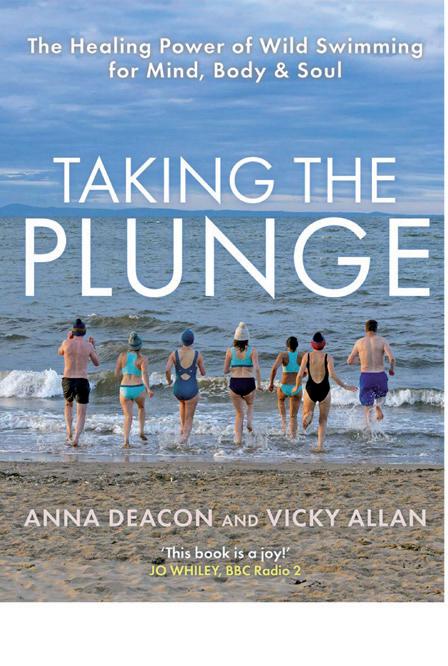

A new RNLI water safety campaign has been launched, in a bid to tackle one of the biggest causes of lifeboat call outs. Between 2017 and 2022, lifeboat crews launched 14,370 times to boaters in difficulty. Just 403 of these shouts were serious incidents. In a bid to reduce the number of these call outs, the RNLI has conducted research into how to try and prevent incidents progressing in severity. '
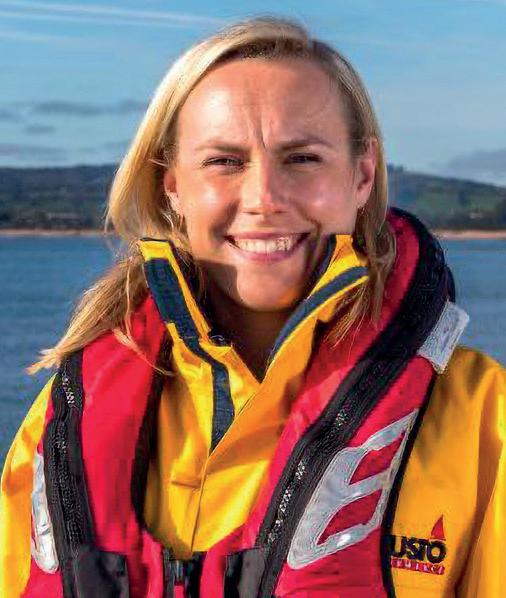
Sarah Pennicard, RNLI Water Safety Delivery Manager
This research has been used to develop new safety advice for boaters, divided into two phases. The first phase was the development of messaging and resources for entry-level boat users who may have easy access to boats but lack experience and expertise. This guidance is available now and has already been put into good use by RNLI water safety volunteers.
Phase two, which is currently in development, will focus on how to encourage more experienced sailors and motor boaters to prioritise their and others’ safety.
FIND OUT MORE For the new safety advice and resources you can share with your fellow boaters, visit RNLI.org/BoatingSafety.
AQUAPAC HEAVYWEIGHT DRYBAG, BLUE
Seriously tough and brilliant for watersports, expedition and wet-weather use. Made from 500D vinyl and featuring shoulder straps. Available in 7- or 15-litre capacity.
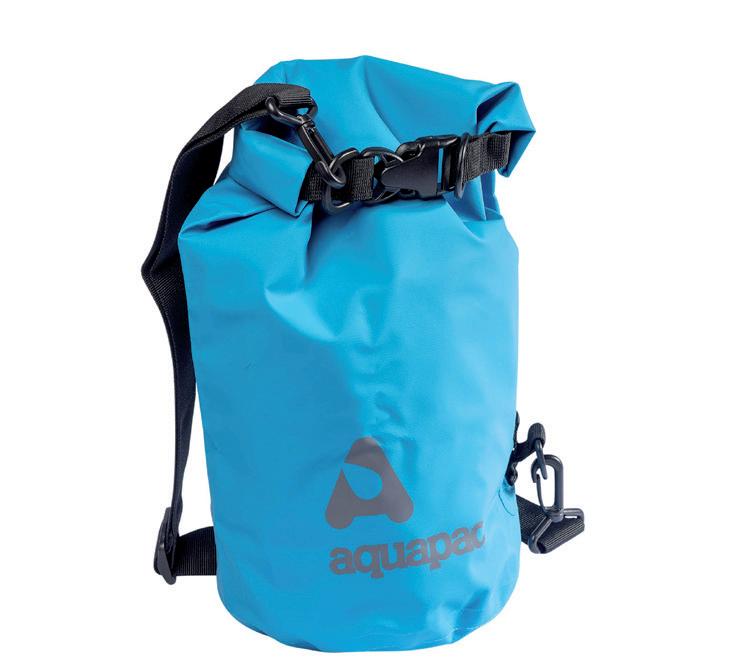
In this issue of Offshore, quotes, practical advice and lifesaving tips are brought to you by:

TIM DORAN
RNLI NATIONAL WATER SAFETY PARTNER
Tim creates high-impact water safety partnerships that save lives. He also swims marathons and surfs waves.

VICKI LINTON-CROOK RNLI WATER SAFETY OFFICER
Vicki's a lifeguard and part of the Brighton RNLI team, preventing drowning by reaching local people with water safety education.

KITTY NORMAN
RNLI LIFEBOAT TRAINER AND POOLE RNLI CREW MEMBER
Kitty equips RNLI crew members with the skills they need to save lives and stay safe. She also volunteers on Poole lifeboat.

LIFEBOAT OPERATIONS MANAGER, COWES RNLI
As well as looking after operations at Cowes RNLI, Mark helps the Round the Island Race go smoothly each year.
Keep your phone accessible while protecting it. The ultrathin anchor sits between your phone and its case, feeding through the charging point. Compatible with corded and wireless charging.


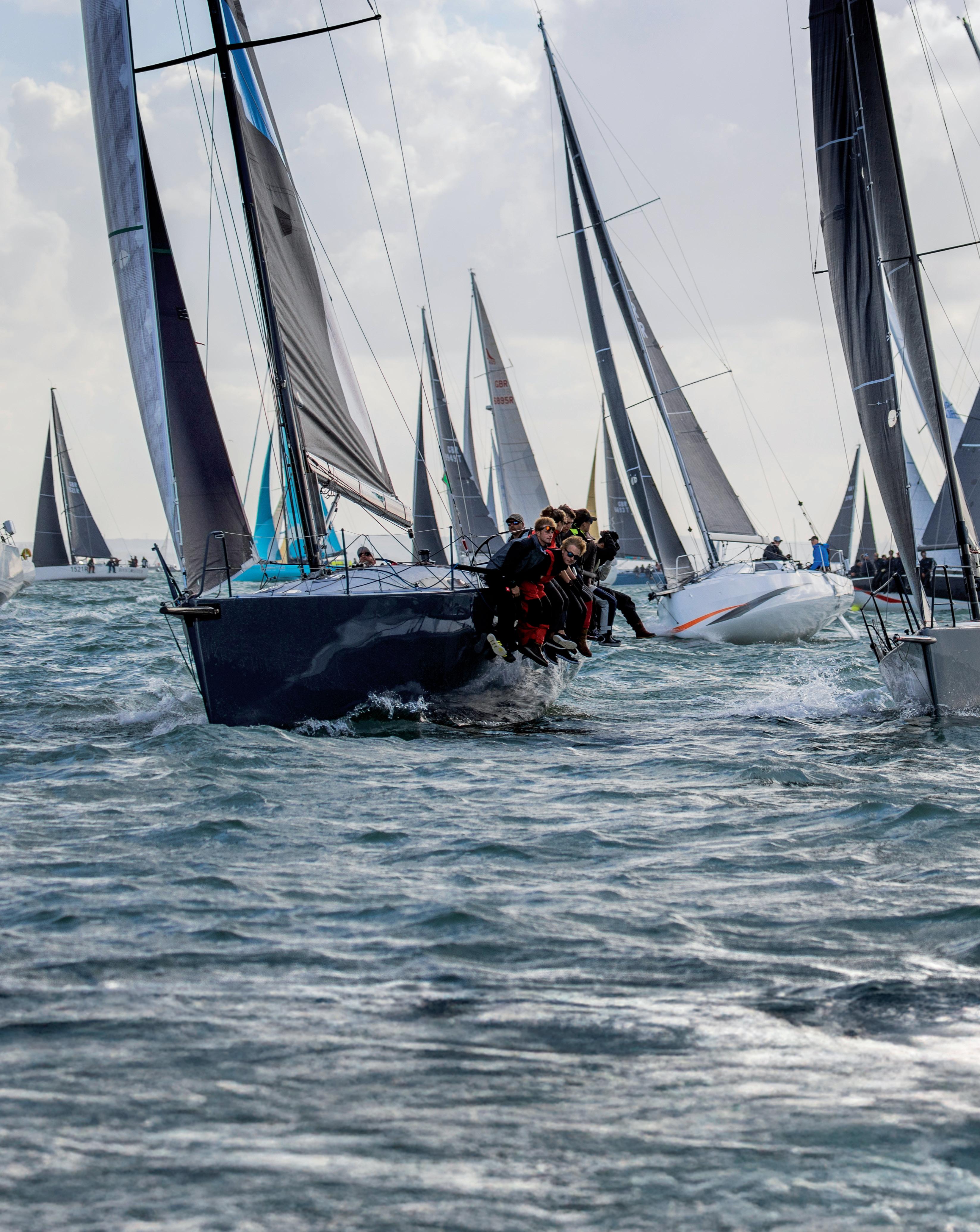
The RNLI works closely with the Island Sailing Club and the Coastguard to keep people safe in this iconic and historic sailing event. But how is safety cover provided? And what else do RNLI volunteers do to keep people safe?
The first race around the Isle of Wight was in 1931 when just 25 competitors took part. While the boats have changed substantially since then, the course remains pretty much the same: a 50 nautical mile dash around the island, starting and finishing in Cowes.
This jewel in the Island Sailing Club’s crown is an eagerly anticipated fixture on the racing calendar. Popular with
amateur racers and cruisers, as well as professional and training crews, today there are well over 1,000 boats registered every year.
To recognise our longstanding support for the race and to celebrate our 200th anniversary, the RNLI had the honour of being named the race’s official charity in 2024. The fundraising this generated was hugely welcome, but for the lifeboat crews it was business as usual.
‘A SAFE RACE IS A GOOD RACE’
‘If we have a safe race, we have a good race,’ says Race Safety Officer Mark Southwell.
‘My priority is to ensure everyone running or supporting the race is involved, consulted and listened to. The key to success of search and rescue operations afloat is good communication, and it's no different ashore as we plan for the big day.’
HM Coastguard is responsible for coordinating maritime search and rescue
assets on the day. But planning an operation of this size in this location involves the cooperation of many other organisations too.
‘A maritime risk assessment is circulated to the three port authorities involved months before the race,’ explains Mark, who is also the Lifeboat Operations Manager at Cowes Lifeboat Station, located next door to the sailing club. ‘The Coastguard, RNLI lifeboat


stations, independent lifeboat stations, the Maritime Volunteer Service, National Coastwatch and the ferry companies are all consulted. Detailed planning continues from there.’
There is plenty of safety advice available to sailors prior to the race, including a free lifejacket clinic outside the Helly Hansen shop in Cowes, and in their race pack. ‘The main event is a safety briefing on Cowes Parade,’ says Mark. ‘We have a lot of information to get across in quite a short space of time so we find a Q&A format works best. The whole thing is videoed for those who can’t attend.’
With shipping plying up and down Southampton Water and a plethora of other commercial and recreational craft, the Solent is one of the busiest

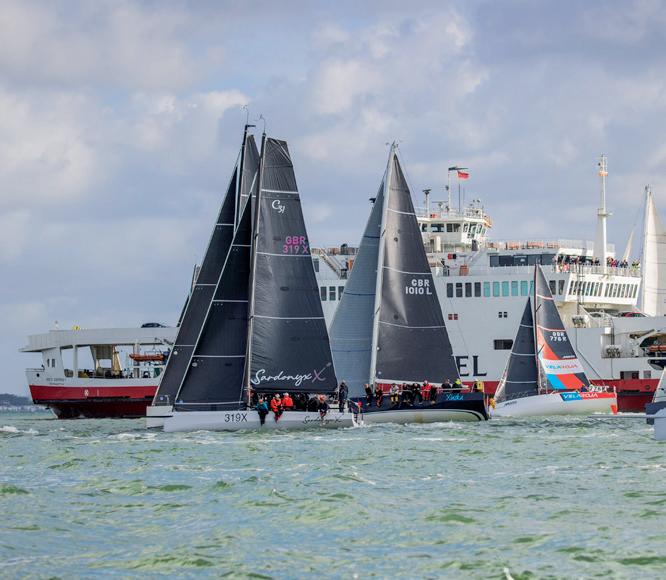

' When they’ve put to sea, sailors are responsible for their own safety'
MARK SOUTHWELL, LIFEBOAT OPERATIONS MANAGER, COWES RNLI

‘We can call on the Coastguard helicopter and rescue teams on the shore. With their binoculars they can see boats, reefs and ledges on the back of the island to help us find a particular yacht. The pre-race notes give race crews details of wrecks and other course hazards.
‘In 2022, a woman on a small yacht was injured when the boom came across and hit her on the head. It happened in an area known as the Ships’ Graveyard and the sea was quite lumpy. Despite the conditions, we were able to get our paramedic across to help with the airlift.’
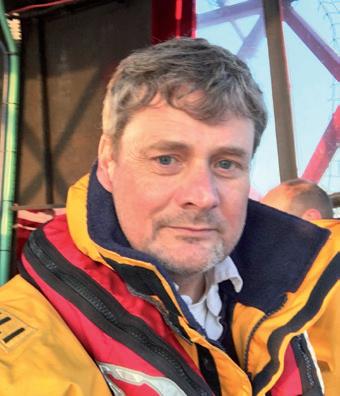

‘Going around The Needles is magical, and the usual pile up at St Catherine’s provides a bit of light entertainment, before you start tacking up the Bembridge shoreline. You always have to know what’s around you and be aware that the tide and winds can change.
‘There are so many people that make an event happen, not just the competitors –those people are on the water before the race and are the last to come in after a long old day.’

FIRST EVER RACE
22 MINUTES 1931
2 HOURS
23 SECONDS
Fastest time to complete the course (in 2017)
7
Depending on the conditions, RNLI lifeboats from up to seven lifeboat stations (on the island and the mainland) could be involved on race day, as Mark explains: ‘Yarmouth will position theirs at The Needles, the Isle of Wight’s most westerly point. The sea conditions there can change drastically without warning. They’ll stay out for as long as needed and sometimes will circumnavigate the island with the yachts. Bembridge all-weather lifeboat will provide cover on the eastern end of the island for the final leg of the race.
‘Here at Cowes, the crew launch for the start of the race and when the bulk of the fleet comes back towards the finish. We remain on pager for the duration of the race. The other lifeboats, including the independents, might stay out all day.’
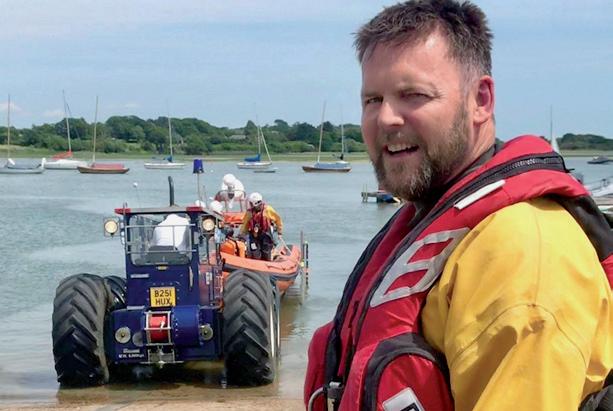
'One of our challenges can be finding the vessel calling for help in a wall of yachts. A sail number, orange smoke flare or accurate GPS position will help us get to you much quicker'
waterways in the world. Unsurprisingly, this level of activity impacts the start of the race.
Mark says: ‘The Port of Southampton normally shuts to all traffic, except passenger ferries, for 5–6 hours and doesn’t reopen until the last competitor has departed. The shape of the Isle of Wight – a diamond – together with the tidal window, dictates that the boats race anticlockwise. Competitors have to reach The Needles on an ebbing tide before the tide turns, otherwise they’d struggle to get round.
‘The start line extends from around 1½ miles from Cowes on the Isle of Wight to Calshot Beach on the mainland. We stagger the start times, but with over 1,000 boats to get over the start line we also have to plan where to park them while they’re waiting to set off.
‘In a traditional club classification race the slowest boats set off first, but in this race they start last. It’s safer to get the biggest, fastest boats out of the way first.’
MANAGING SAFETY ON THE DAY
‘My job is all in the prep,’ says Mark. ‘Once the race has started, the safety officer’s job is done. When they’ve put to sea, sailors are responsible for their own safety.
‘Of course, I keep an eye on what’s going on. If anything major were to go wrong I’m part of the crisis management team.
‘The race box is at the Island Sailing Club. From there, race officers count all the yachts in and out, and record their start and finish times. The Coastguard coordinates search and rescue.
‘If available, the Island Sailing Club will provide escort boats. They’re not safety boats but they do give us a view of what’s happening on the water. If yachts need to arrange a tow and aren’t in any danger we ask them to make their way to Sandown Bay or another safe anchorage and contact their insurers.’ ■
Words: Rob Westcott
Photos: Nick Edwards, RNLI/(Andy Parish, Nathan Williams), The Island Sailing Club
Despite its nickname, the Granite City is ideal for watersports, wildlife and stunning coastal walks


VISITORS ALL YEAR ROUND THE SURF ATTRACTS
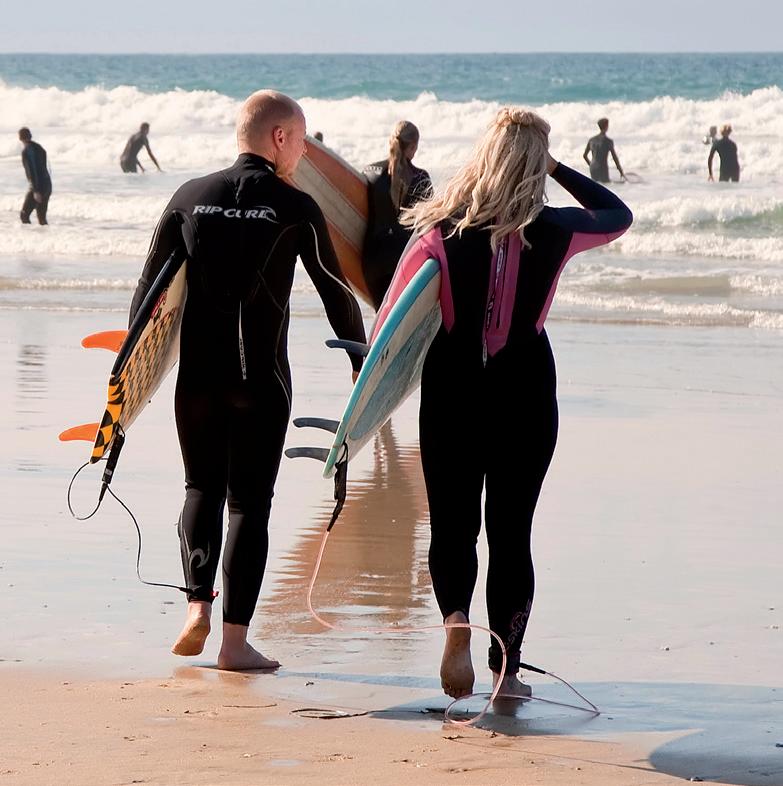

LIFEBOAT
ABERDEEN

Aberdeen is quite unique as, to get here, you go through swathes of massive fields and then suddenly a city appears right next to the sea. We’re also the only coastal city in Scotland.
We’ve got everything from rugged cliffs and sandy beaches, to the wind farm and commercial harbour. There’s so much to do. The city has embraced the fact that it’s on the coast, with Aberdeen Lifesaving Club, Scot Surf and other setups on the seafront. It makes it a good place to participate in watersports.
Torry is almost an expansion of the harbour, and its community have supported the establishment of the Greyhope Bay Centre, building a cafe and dolphin watching space out of old shipping containers. It’s a rustic space that embodies the coast and Aberdeen’s energy heritage.
Private cruises offer harbour tours and trips out to sea for dolphin and whale watching. They’re often followed by fish and chips to round things off. If not, Footdee next to the harbour entrance has a choice of fantastic independent street food vendors.
When walking along the beach, be careful of sandbars formed by the weather. When sand gets washed up into the bay it can create islands that
look fun to visit but you can be easily stranded on.
Just north of Aberdeen Beach is Balmedie Beach, where there’s ideal dog walking among the sand dunes. And, although it’s a bit far, you could even walk our entire coastline from Aberdeen towards Peterhead!
South of Aberdeen, you can get to lots of places along the clifftops, including little coves with their own mini beaches. You have the right to roam here in Scotland, so you can go where you like as long as you leave it as you found it.
'People don’t realise how much sea life is available to them'

main beach spans the length of the city: Aberdeen Beach. The bay’s enclosed here, so the sea can get quite rough. People travel here from all over the country for surfing – including for a popular annual surfing competition in April.
If you want to learn, visit Scot Surf School – there are lessons during the summer for kids, and taster sessions for adults as well. You can also hire a wetsuit from there for watersports or swimming. The company founder Campbell Scott provides a daily




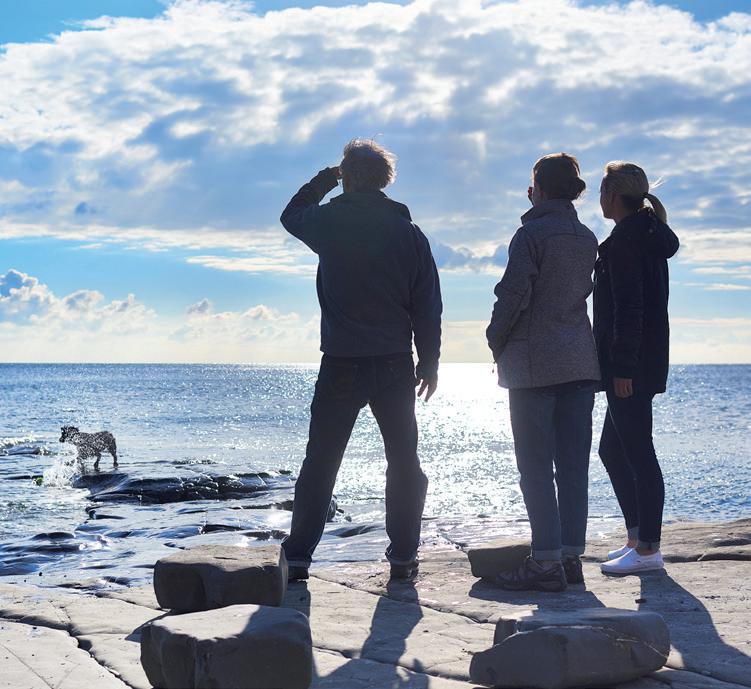
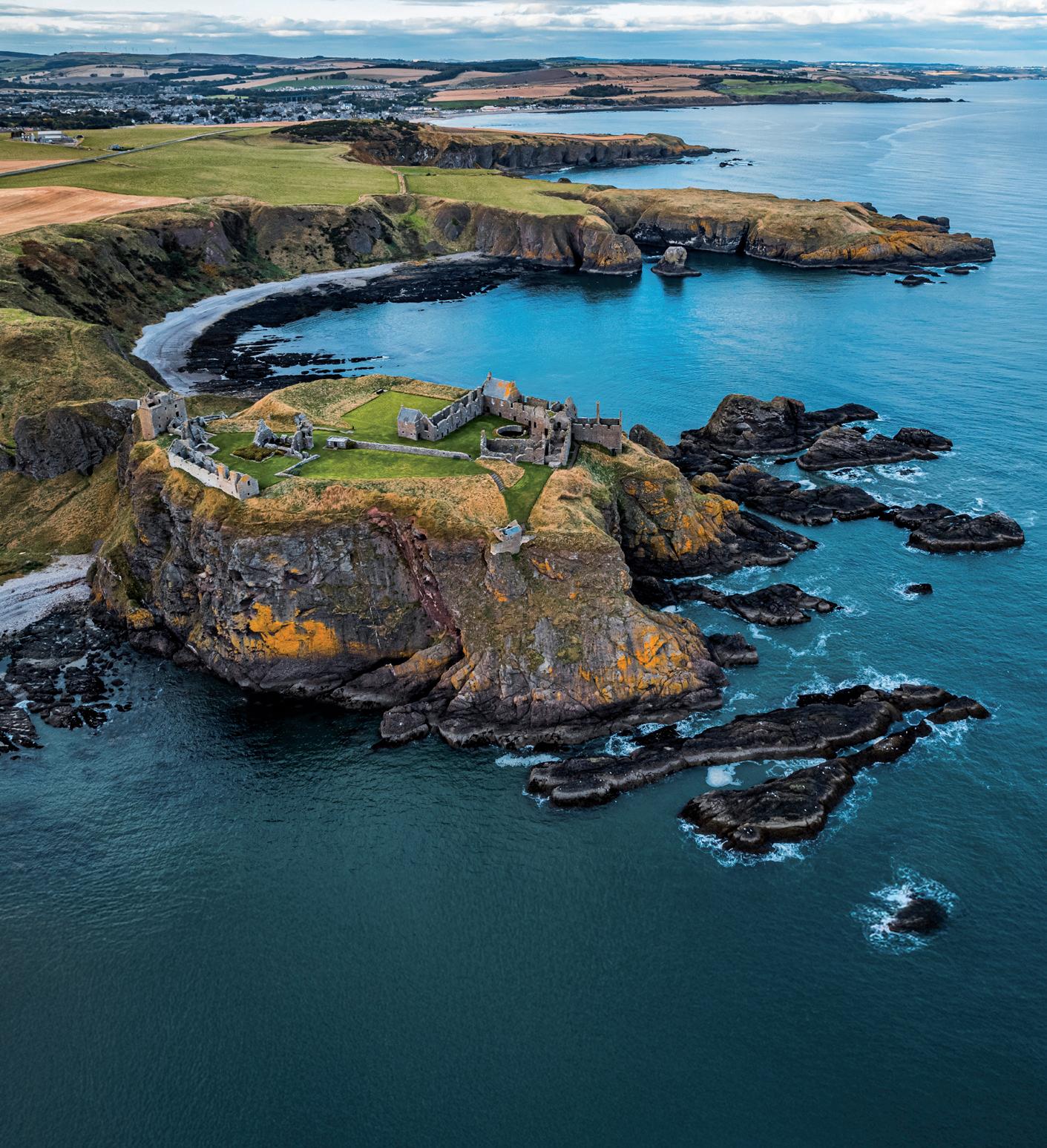
If you’d like a break from the coast, then Aberdeenshire is home to 283 castles. Located in forests, on mountains and on top of cliffs above the sea, there are more castles per acre here than anywhere else in Britain. With fortifications from the Iron Age to the 18th century, there’s plenty for history buffs to explore. Dunnottar Castle (pictured) is just one of the spectacular castles you can visit.
weather update on Instagram, advising people where to surf and how safe it is to go out.
'On a beautiful day, the granite will sparkle'
People will swim off the beach here all year round – although with the sea temperatures, it’s more often cold water dipping. Even when the weather’s a bit rubbish, they’re not shy! You’ll see other swimmers in specific areas along the beach that are safer.
Aberdeen has two rivers running through it, the River Don in the north and the River Dee in the south. These are popular with paddleboarders and kayakers, but most head to the Don as it runs past Seaton Park and is a bit
quieter. The River Dee tends to be more dangerous because it runs into the busy commercial harbour. There are university rowing clubs on the Dee and you can watch them during the week, when they’re out training.
The sailing clubs are based inland for the winter, moving to Stonehaven Harbour (south of Aberdeen) for the peak summer season. If you want a spectacular location to learn to sail, they do taster sessions and RYA courses.

From classrooms and sailing clubs to promenades and harboursides, the RNLI has a crew of dedicated volunteers helping people from all walks of life to stay safe near the water. Here, three of them share why they give up their time to play their part in this lifesaving work

BOB TAYLOR WATER SAFETY ADVISER, BRIDLINGTON
I’ve had a hankering to get involved with the RNLI since I was 6 years old. I started off as a fundraiser, then volunteer crew member at Bridlington. In 2019, I became water safety officer.
You need to have the desire and passion for saving lives at sea, for getting the message across.
Being conversational, not confrontational. It’s not about talking down to people or bombarding them. It’s finding the right angle to get through to them. For example, if I’m talking with a kayaker, I might ask if they have a sticker on the bottom their craft with their contact details.
We have set materials that have been crafted precisely. Then we’re given creative licence in how we present them, so we’re not just repeating safety messages parrot fashion in a dull way. We can personalise the message with our own stories and things we relate to, but the materials are there for us to use.
‘ Make a difference in somebody’s life and have a laugh too’

We are one corner of the livesaving triangle, with lifeguards and lifeboat crew. Our job is prevention. We hate to take jobs away from our colleagues but that’s the idea –if they’re launching less often, than we’ve done our job!
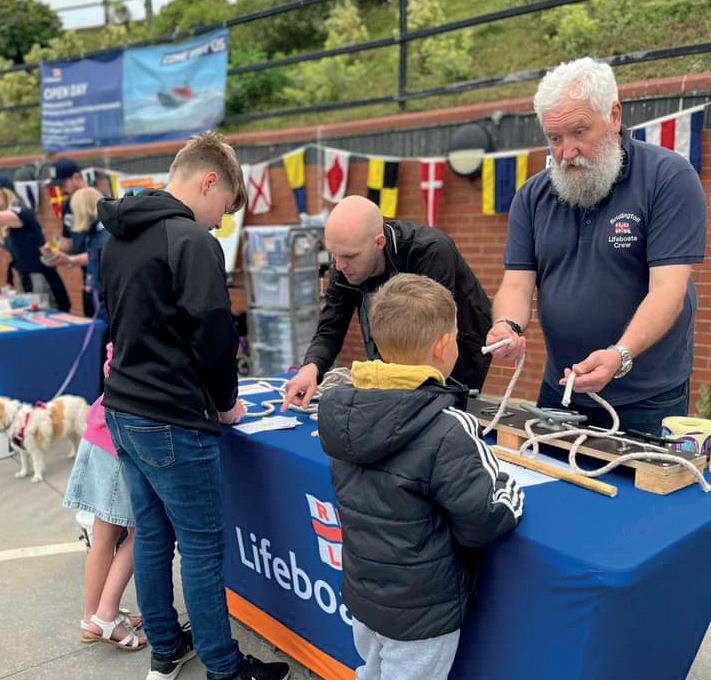
‘ It’s nice to be able to pay something back and do something worthwhile’

LIBBY TALBOT WATER SAFETY ADVISER, FISHGUARD
I’m a full-time mum and a carer for an elderly relative. Being a water safety volunteer has given me an interest alongside that.
I had no previous nautical experience or water safety training. I’m not even a good cold-water swimmer! You don’t need to have a watersports background to do this, just a desire to get the safety messages out there.
It's very flexible. I’ll be told there’s a water safety request in my area, and then I’ll arrange a time that works for me. The training is fixed, but there’s no expectation. I just like to do as much as I can – if I can do it, I will do it.
When I started the role, I realised that many people don’t have knowledge of water safety. So it’s great to go into schools and talk to children – teaching them to keep safe at the beach, be aware of tides, and so on.
I’ve even had children come up to me later on the beach and say: ‘I checked tides, I’ve been careful!’ Having that follow up is what it’s all about. It’s nice to be able to pay something back and do something worthwhile. If it just saves one life, then that’s good.

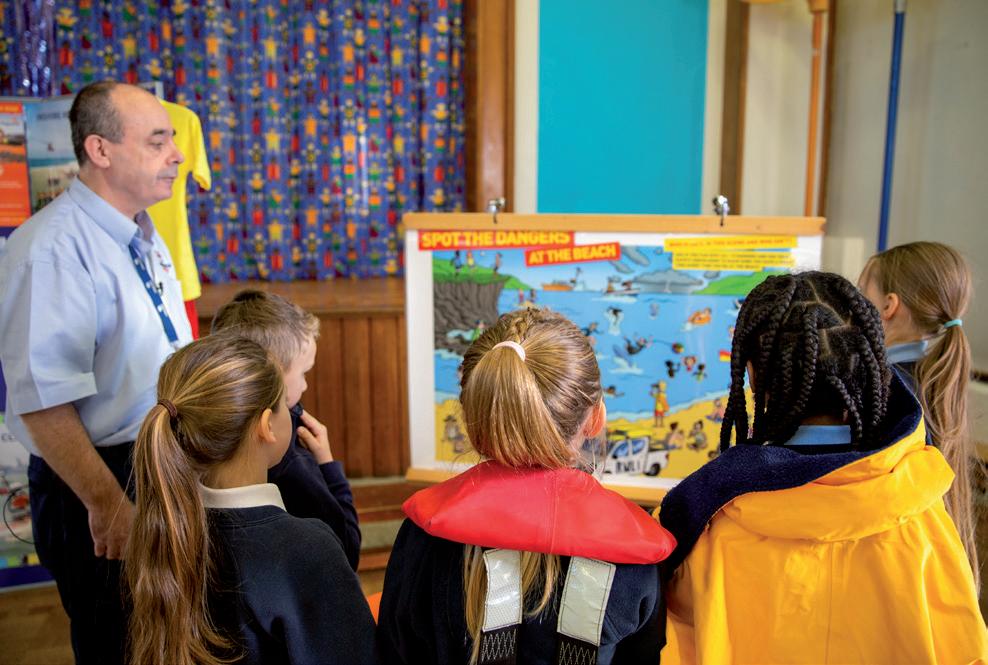
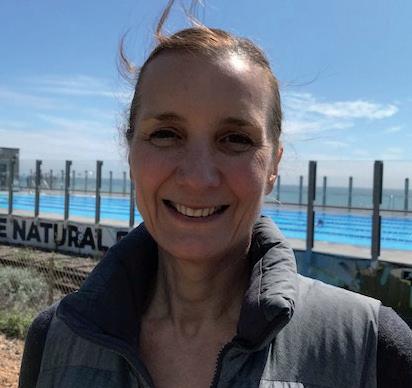

‘The more people we get to send the messages out, the more lives we can save’
VICKI LINTON-CROOK WATER SAFETY OFFICER, BRIGHTON
I’m an open water swimmer and worked as a lifeguard in the summer. It highlighted that so many people are unaware of the dangers. So when the water safety role came up at Brighton RNLI, I jumped at the chance.
We’re trained to talk to anybody – whatever reason they have to be in or near the sea. Whether sharing Float to Live advice with families or helping dog walkers avoid dangerous waves sweeping their dog out to sea, it’s all about sharing information so that everyone can enjoy their time near the water and avoid getting into trouble.
The training we get for our role is really good. If we need something, the Water Safety Team will come and deliver it. For example, if we go to a sailing club, we’re trained in the different devices for calling for help and how to check lifejackets.
The lovely thing about the RNLI is that they really respect the volunteer role. They know that you do what you can in the time you’ve got. We’re part of Brighton RNLI and work with the other emergency services too. It’s wonderful to be part of a team. You can make a difference in saving someone’s life and have a lot of fun too.
Our latest volunteering roles are advertised on the RNLI website. There you can set up an alert to notify you of future opportunities or express your interest, if a suitable role isn’t currently available.
When you apply, you’ll go through an informal selection process then be registered and inducted into your role.
Many people who drown never intended to enter the water. Would you know what to do if you got into difficulty unexpectedly?

As the weather warms up and more of us are spending time on or near the water, sea temperatures around the UK and Ireland remain cold. In fact, average sea temperatures are just 12°C, and inland waterways are colder still – even in summer.
Cold water can seriously affect breathing and movement by increasing heart rate and blood pressure quickly. Anything below 15°C is defined as cold water, so the risk is significant for most of the year. The risks increase if we follow our instincts and thrash around or try to swim after sudden immersion. Cold water shock is our body’s natural response to entering cold water. It can make you
gasp uncontrollably and can very quickly lead to cardiac arrest or drowning.
Floating, even for a short time, allows the effects of cold water shock to pass. It enables us to regain control of our breathing and our chances of survival greatly increase. Recent research carried out by the University of Portsmouth and King’s College London (KCL) is helping our understanding of how biological and physiological factors contribute towards people’s ability to float. Finally, there are the stories told by float to live survivors themselves.
Opposite, RNLI National Water Safety Partner Tim Doran explains how to keep you and your loved ones safe in five simple steps.


Tilt your head back, submerging your ears. Spreading out your arms and legs will improve your stability. Gently treading water can help to keep your airways clear of the water too.
Relax and try to control your breathing. Once your breathing is under control, call for help or swim to safety.

Your legs may sink, but that’s OK – everyone floats differently. Moving your hands may make it easier to stay afloat.
It’s a good idea to practise how to float in a safe environment like a swimming pool. It’s a valuable lifesaving skill which could save your life.
Make sure your loved ones know what do if they get into difficulty by helping them to learn how to float too. TILT YOUR HEAD BACK


You’re enjoying a day out sailing in late summer. The wind’s dropped so you’re motoring along when suddenly you hear a change in the sound of the engine.
Thinking it’s just a bit of weed, you put your boat into reverse. The engine clunks to a halt. You have a fouled propeller. You’re not in immediate danger.

It can happen to anybody – in 2023 there were 1,293 RNLI call outs to people with fouled propellers and equipment/ machinery failure. Before you even consider leaning over the side or entering the water, you should inform the coastguard [A]. Make sure the engine is off and stays off. Deploy your anchor. Obviously, leaning over the edge can be risky. If you end up in the water, is there anybody with you to help get you out? Is it something you’ve practised? Even in late summer, the water can still be around 15°, so cold water shock is a danger. Even with a wetsuit, you can soon feel the effects of the cold. Knives and cold water can be a recipe for disaster. Your plan of action depends on a number of factors – your crew, the conditions and your location. Whatever action you take, keep the coastguard informed.
1,293
B First, use a boat hook over the side to work out what you’re dealing with?
C Don a wetsuit as the water is still cold, and free the prop with a rope cutter? A Call the coastguard?
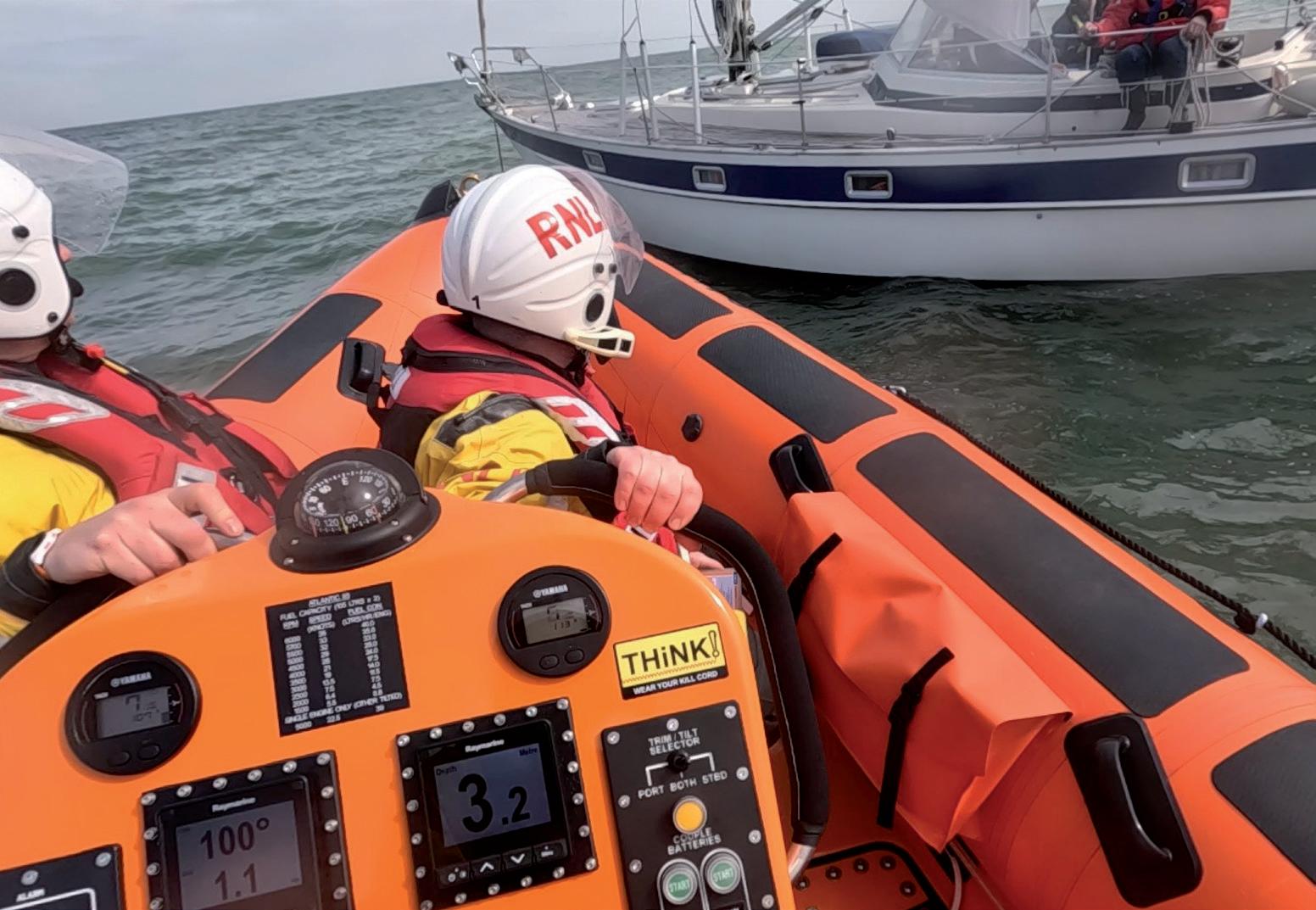
For three people aboard a 10m yacht in Studland Bay, fouling the propeller on a marker buoy was just the start of their troubles. Next the engine overheated and then one of the crew became seasick.
Poole's B class lifeboat crew were there within minutes. A lifeboat crew member climbed aboard the anchored yacht and the seasick sailor was taken swiftly back to shore on a local police boat. The yacht was now clear of
the buoy, so the crew sailed to safe harbour, escorted by the lifeboat. Back at the lifeboat station, the seasick sailor began to feel much better –after tea and biscuits.
Crew Member Stirling Taylor says: ‘We were glad to help the crew of the yacht get safely ashore. With a fouled propellor, an overheat and a seasick crew member all happening at once, the skipper did the right thing to call for assistance.’ ■
Your stories can help us spread our safety messages. Please share them with us by emailing YourStory@RNLI.org.uk.